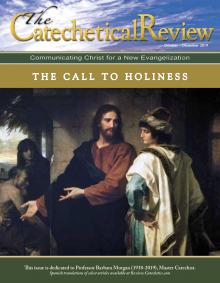The fifth chapter of Lumen Gentium on “the universal call to holiness” reads very much like it could have been composed by St. Francis de Sales, as it echoes what he had written around 1609 in the first pages of his Introduction to the Devout Life. What St. Francis refers to repeatedly throughout his text as “devotion” could easily be rendered “holiness” or “sanctity.” This vocation is universal; that is, there is no member of the Church, configured to Christ dead-and-risen in the waters of baptism, who is not called to sanctity. However, what precisely this sanctity will look like will vary significantly depending upon one’s particular vocation within his Body and the details of one’s life.
Formed in Spousal Love
The diocesan priest is a man configured to Christ, Head of the Body, and espoused to Christ’s Bride, the Church. As the Church is formed from the love that pours forth from the side of Christ crucified, a man who is ordained a priest must find his identity in that wounded side of Christ. The beloved disciple in the Gospel is portrayed as resting in sinu Jesu, on the breast of Jesus (Jn 13:23). The Son, who dwells eternally in sinu Patris (Jn 1:18), by his incarnate existence extends his filial life to those who are reborn in baptism. They too, through him and with him and in him, dwell in sinu Patris. But since Jesus is revealed as the way to the Father (Jn 14:6), and as the one who makes the Father known (who has literally “exegeted” the Father, Jn 1:18), they must first dwell in sinu Jesu. The third century theologian, Origen, remarked that no one can understand the Gospel unless, like the beloved disciple, he learns to recline on the Lord’s breast. Intimacy with Christ is at the heart of the life of the baptized. At ordination, the faith and witness of the baptized man takes on (quite literally) a new character. The one who was configured to Christ in baptism and sealed with the Spirit in confirmation, receives a new configuration he is, by his ordination, configured to act in persona Christi capitis, in the person of Christ as head of the Body. He is conformed to Christ in act, so to speak, configured to Christ as he gives himself for his Bride, the Church. This is why the spousal love witnessed on the Cross is the font of the Church, the source of its sacramental life (the near unanimous view of the Fathers), and the very form of the priestly life. For the priest, the side of Christ in which he rests remains forever the pierced side, as Christ’s wounds do not disappear at the resurrection but remain the eternal sacrament of his love.
In much the same way that a married couple most perfectly embodies the self-gift that defines their identity in the act of conjugal love (such that they are considered as consummating what was ratified within the Rite of Marriage), so the priest, at the altar and in offering Christ’s sacrifice in the celebration of the Mass, most perfectly embodies the self-gift that defines his identity, his espousal to Christ’s Bride, now the priest’s as well. Christ’s words, made the priest’s own (or perhaps the priest’s words, in union with Christ’s), express the priest’s spousal love for the Church. Gazing at the chalice, lifted at the consecration, it is not unusual for the priest to see himself reflected in it. In some respects, this captures the essence of his vocation: priesthood is not merely or even primarily something he does, it’s who he is. The conflict between functional and ontological understandings of the priesthood can be resolved easily if the former is always related to the latter: what the priest does (celebration of sacraments primarily, but many other pastoral tasks as well) must be rooted in and flow from who he is. His identity is determined not by these acts themselves, but by these acts as expressive of who he is by virtue of his ordination.
The rest of this online article is available for current Guild members.
This article is from The Catechetical Review (Online Edition ISSN 2379-6324) and may be copied for catechetical purposes only. It may not be reprinted in another published work without the permission of The Catechetical Review by contacting [email protected]

















